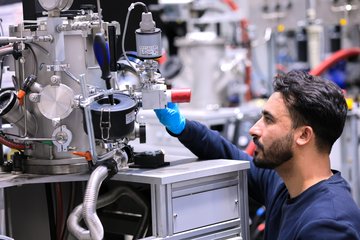All genres
1.
Journal Article
Local strength of bainitic and ferritic HSLA steel constituents understood using correlative electron microscopy and microcompression testing. Materials and Design 236, 112507 (2023)
2.
Journal Article
Automated classification of granular bainite and polygonal ferrite by electron backscatter diffraction verified through local structural and mechanical analyses. Journal of Materials Research 38 (18), pp. 4177 - 4191 (2023)
3.
Journal Article
Application of a nanoindentation-based approach for parameter identification to a crystal plasticity model for bcc metals. Materials Science and Engineering A 881, 145373 (2023)
4.
Journal Article
The role of incoherent twin boundaries on the plasticity of Cu micropillars. Materials and Design 232, 112812 (2023)
5.
Journal Article
Unsupervised clustering of nanoindentation data for microstructural reconstruction: Challenges in phase discrimination. Materialia 28, 101750 (2023)
6.
Journal Article
Hydrogen embrittlement of twinning-induced plasticity steels: Contribution of segregation to twin boundaries. Scripta Materialia 225, 115187 (2023)
7.
Journal Article
Probing porosity in metals by electrical conductivity: Nanoscale experiments and multiscale simulations. European Journal of Mechanics - A/Solid 97, 104777 (2023)
8.
Journal Article
On the interplay between microstructure, residual stress and fracture toughness of (Hf–Nb–Ta–Zr)C multi-metal carbide hard coatings. Materials and Design 224, 111323 (2022)
9.
Journal Article
Size scaling in bi-crystalline Cu micropillars containing a coherent twin boundary. Acta Materialia 230, 117841 (2022)
10.
Journal Article
Strategies for damage tolerance enhancement in metal/ceramic thin films: Lessons learned from Ti/TiN. Acta Materialia 228, 117777 (2022)
11.
Journal Article
Faceting diagram for Ag segregation induced nanofaceting at an asymmetric Cu tilt grain boundary. Acta Materialia 214, 116960 (2021)
12.
Journal Article
On the fracture behavior of Cr2AlC coatings. Materials and Design 206, 109757 (2021)
13.
Journal Article
Quantitative insights into the dislocation source behavior of twin boundaries suggest a new dislocation source mechanism. Journal of Materials Research 36 (10), pp. 2037 - 2046 (2021)
14.
Journal Article
Orientation-dependent plastic deformation mechanisms and competition with stress-induced phase transformation in microscale NiTi. Acta Materialia 208, 116731 (2021)
15.
Journal Article
Influence of strain rate on the activation of {110}, {112}, {123} slip in ferrite of DP800. Materialia 15, 100983 (2021)
16.
Journal Article
The fracture toughness of martensite islands in dual-phase DP800 steel. Journal of Materials Research 36, pp. 2495 - 2504 (2021)
17.
Journal Article
Microscale plastic anisotropy of basal and pyramidal I slip in pure magnesium tested in shear. Materialia 14, 100932 (2020)
18.
Journal Article
Efficient characterization tools for deformation-induced damage at different scales. Production Engineering 14, pp. 95 - 104 (2020)
19.
Journal Article
Dislocation plasticity and detwinning under thermal stresses in nanotwinned Ag thin films. Acta Materialia 198, pp. 61 - 71 (2020)
20.
Journal Article
Atomistic deformation behavior of single and twin crystalline Cu nanopillars with preexisting dislocations. Acta Materialia 197, pp. 54 - 68 (2020)











